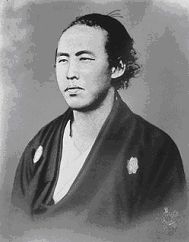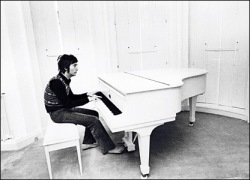Curiosity
I’ve been thinking about what “Curiosity” is — What am I curious about? Does it make me who I am? What does this mean? Generally speaking, I realized my interest is two fold — things I can learn about and things I can do.
It’s counter-constructive to explain ‘doing’ in words, so I decided to compromise and attempt to compile a list of subjects/things/people I’ve been interested in over the years… Few of the topics I’ve obsessed about and still do, some subjects I used to be more interested but not as much any more, some subjects I don’t know much but I’d like to know more about. So here it is:
what are user interfaces?
Books are primitive user interfaces. Page turning is a User Interface action: turn the page forward, turn the page backward and watch what happens. Closing the book, these are actions that can be taken against the object itself to change the information and look and feel. You interact; the look and feel is the page is the paper that it is made out of. It is the font used; it is the spacing of the typography. Paper is fundamentally perceived as a plane, not a space.
Space, architecture is a user interface too. Much less discrete and complicated, the look and feel is the feeling of the space that you get, carefully crafted from the details to make a distinct feel of the space. The interaction of the interface is the rooms, you go in a room, or another room, and there are certain tasks suited to specific needs that can get taken care of only in those rooms. Bathrooms, sinks, are designed to exist in carefully thought out places before through careful understanding of spacing and planning before building the house. A careful holistic approach is necessary. Space is fundamentally perceived the way we see things, it re-enforces our 3D reality.
PCs have user interfaces too. They have graphical user interfaces (GUIs), where people look at screens and input their understanding of the data and read their understanding of their data. They are much like books in the sense that there are very specific tasks and tools that you can work with. But unlike paper, which can only be written on, there is a more real-time aspect of being able to change the paper itself. Which only begs the question, what is a user interface?
The modification of User interfaces to fit needs of the user, in other words, fitting the user’s content to the interface, how low you have to drop for the content and interface to work together to create a truly seamless and amazing experience. Obviously the higher levels take a lot less time and energy to change, the lower levels take a lot more time and energy and only happen very so often.So if you break it down, the comparison goes something like this:
tech ∩ design
designing UXs – layering on top of reality
Taking a look at the startups that have seen success or growth in New York in the past 6 months, there are a few characteristics that I’ve noticed across the board. Many of them seem to have a service or product that defragments real life situations/problems by focusing on building a great user-experience solution that leverages pre-existing infrastructure as much as they possibly can. By building a UX overlay on top of real world situations/problems using as much existing infrastructure as possible, not only have they saved time, money & effort, but also freed themselves up to focus on architecting a great experience.
It’s not simply about the experience of the device that the user has, in the traditional UI/UX sense. Startups that have been moving forward in NY have been able to take a holistic understanding of user experience of both off and online experience, where the input of the user is at the same location or in the same sphere of influence as the output of the experience (take Foursquare for example.) By bringing different aspects of real life problems or situations together, the overlaying UX, which is sensitive to on and off line activities as services, acts as a hub to make the overall experience focused on solving one specific aspect of the problem, really well.
But without the recent surge in cheap modular bespoke PaaS, IaaS, SaaS services (Google App Engine, AWS, Heroku, Twilio, and much much more), none of this would have been possible. With the overhead cost, the cost of entering the market dropping so much, it’s so easy to build a website now, if you know how. Yet I think the real push that has made software more accessible is the recent explosion of helpdesk sites (StackExchange, specifically StackOverflow, Forrst, Quora and many more), they really have provided unprecedented level of access to information and wisdom that would not have otherwise been accessible in the past. (Also possible because the infrastructure became cheap to build easy Q&A sites rolled out with RoR, Django stuff like that.) With this widespread dissemination of knowledge built on top of the rise of cheap and modular infrastructure, all of a sudden you have a rise of UX design conscious startups that want to build layers of experiences over the real world. It’s definitely an intersection of tech and design.
doing what works well
Part of this is about doing what works best in New York. Though there has been a huge rise in startups in NY, many have been software plays, you just won’t see deep technological innovation happening in NY.
SF/Silicon Valley does what they do best, which is deep technological innovation. With the higher education facilities like Stanford and Cal churning out tech/engineering related talent, and labs/research centers like IBM research, NASA-Ames and PARC that foster supportive innovative R&D environments, it has a unique and favorable environment to build innovative hardware and develop infrastructure.
Yet it seems that New York has found out what it is good at too. Having the strong culture that it has for design and media, it has taken advantage of its environment and has started to do what it does well. It’s no coincidence that General Assembly‘s Mission Statement states that it is:
“an urban campus for entrepreneurs seeking to transform industry and culture through technology and design.”
Changing industry and culture through the intersection of tech and design. Sounds like what NY does best, I think.
the way forward
Silicon Valley has always built the content delivery framework and the content deliver system. While New York still has a tremendous amount of infrastructure that needs to change (which is great), the content itself is and has always been innovative. With the truly amazing and awesome changes that will take place in the next 50+ years (not just in tech), I can’t help but notice that they will grow into a symbiotic relationship in a changing world.
to imagine fearlessly

Before every new era, every time period of great growth and innovation, there is a crucial sequence of events that take place. Before the large paradigm shift takes place, there is a time period that lays the foundation for which said foundation eventually shapes and dictates the era, forever – the calm before the storm if you will. Within the calm before the storm and the events leading up to it usually lie the possibilities and opportunities to imagine fearlessly and to alter that discipline forever. Though this idea applies to pretty much every paradigm shift or revolution in one form or another, it was especially evident in the building of the early 20th century as an era for Modern Physics.
“If at first the idea is not absurd, then there is no hope for it.”
In 1905, Albert Einstein published a paper named “On a Heuristic Viewpoint Concerning the Production and Transformation of Light”, better known to the world as his seminal work on explanation of the photoelectric effect for which he later went on to win the Nobel Prize in Physics in 1921. Though Einstein’s work on his Theories of Relativity and Brownian motion had been popular, his work on the photoelectric effect had validated quantum mechanics a place.
However, if you start looking back, it was Planck’s work on black-body radiation (amongst many other works), that had helped move Physics forward. Around the mid-1890s, Max Planck started to focus on the problem on the problem of black-body radiation. After meddling with the problem, he proposed in 1899 what later became known to be Planck’s law, which described experimentally observed black-body radiation well at the time. The key piece of the work was the Planck postulate, the assumption being that energy was actually quantized, not continuous as energy had been thought of as infinitely divisible in physical systems.
Without Planck’s deep understanding of Boltzmann and Kirchhoff’s work beforehand, and consequently Planck’s work beforehand, Einstein would never have been able to come up with his explanation of the photoelectric effect, or at least not 5 years later. Yet Max Planck had more or less so arrived at a revolutionary idea through the imperative power of logical thinking extrapolated linearly through the facts that were determined to be true within Classical Physics, and had not comprehended the full consequences and use for it. On the other hand, Einstein was able to explain that the energy of photoelectrons was dependent only on the frequency of the light and not its intensity. This theoretical leap as a standard, (something that was in fact directly contradicted James Maxwell’s laws of electromagnetic behavior) was possible only because Einstein was able validate much of Planck’s leap of faith, to have the courage to imagine a new world where the absurd, was actually the standard.
Both men were required to imagine fearlessly: the reluctant revolutionary who built the foundation, and the revolutionary disruptor who shattered the Physics world by making that foundation a standard, as this standard became the basis for the explosion in the advancement of modern physics that followed.
the best is yet to come
It’s been interesting to see tablets start to paint a future where content consumption and personalization will be device agnostic. I think pure value created from mobile will be the ones that can start to become the ‘internet of things’, utilize the cloud, ubiquitous, ambient — ones that really aren’t influenced by what’s fashionable, but rather ones that try to tackle big problems, and harder ones at that. Every revolutionary idea seems to go through phases, like people — first they say it’s completely impossible. Then, it’s possible now, but definitely not worth doing. Then, they say it was a good idea all along. Regardless of what the future holds, it will undoubtedly be awesome.
so, where to?
I had a dream the other day. I got on a train in the tube in London, and there was nobody on the train except for a man all dressed in a sharp black suit. I spoke with him for a while, he listened. He told me to write my dreams and visions I have down on a piece of paper as two bullet points and I did. Then, he told me I should abandon what I have written, once written and let things take shape because I knew that I had a certain almost confidence that these things will happen in ways I can’t even start to imagine now – in the best possible ways.
It really starts with why, and everything that follows just HAPPENS to be a consequence of the why. But this document is more the anchor, so that when scaling, and growing as a culture and organization, I can understand WHY I’m doing the things I’m doing, and so that I can maintain, and build upon the foundation. It may take longer to build but get the foundations right, and the scalability ceases to become an issue.
History is nothing out of the ordinary; history is a series of ordinary actions, framed at extraordinary moments later in time. Yes, I need to shape and follow my path. On the other hand, I don’t think what I’m doing is anything out of the ordinary. Yes, I think we live in an extraordinary time. Yes, I think we have the unprecedented opportunity to do something special, and a chance to move something that was previously thought immovable, a chance to fundamentally change the way we live; but I believe that moving the world itself is nothing out of the ordinary.
how to revolution

I keep thinking that the word ‘Revolution’ is a verb.
There is nothing I appreciate more than craft, because it is magical. There is simply something I cannot explain about a Rembrandt and they way the light shines more than an actual real light reflecting off a surface. The way the UI, or the way an operating system is designed, the way we think about building the cloud into an asset that can be inherited by the next generation — why can’t these things have craft as well?
our crisis; our opportunity

We are the product of our times and our surroundings, that’s something we can’t control. But we always have the room to grow. Our surroundings aren’t as intrinsic to us as much as we think — Belief that we have the opportunity to define our era with our work, and solve the problems of our era is always there. Yet more than ever, it seems that our era is critical. With crises on multiple fronts in an unprecedented manner – a crisis of energy and resources, a crisis of ethics, a crisis of education, a crisis of creativity, and a crisis of culture and what it means to be human – we are only at the edge of a storm. We’ve yet to truly see what globalization is capable of, in both the worst ways possible, but also in unimaginably great ways possible. But these crises, are the very opportunities we are seeking, are they not?
on why I do the things I do

Why do I do the things I do? I can’t explain in words, but whenever I pop that question to myself, I always get the sneaky suspicion that I already exactly know why. Expressing why, now that’s something that’s going to take a lifetime.
In other news, they say that great artists, revolutionaries, master inventors, pioneers in any field always deliver; a work not delivered is meaningless no matter how beautiful, amazing and revolutionary it could have been. Could have been is meaningless. And as I grow, it has increasingly become harder and harder to ignore this gut feeling. More than ever, I’ve found it hard to not follow my path. So much so that, the way I see things has become the very thing that defines me. And this idea to follow my path defines who I am and gives me meaning, to not follow my gut feeling in pursuing these ideas would be to lose meaning in my life — it has become a grave matter of life and death, of necessity and survival. How I live the rest of my life, my well-being, and my very livelihood depends on this now. At the same time, this is not a sufficient explanation of what I am thinking, but that’s part of the fun, isn’t it?




